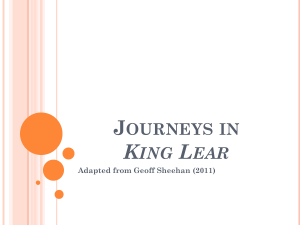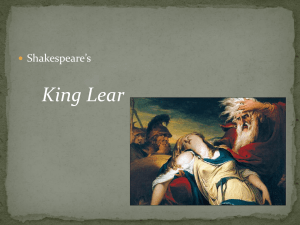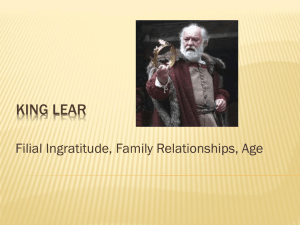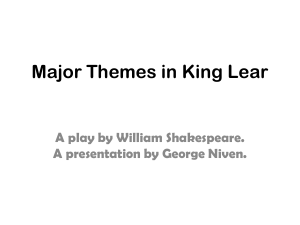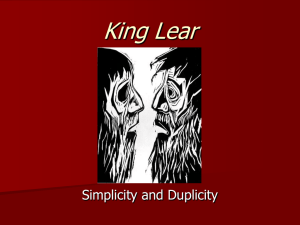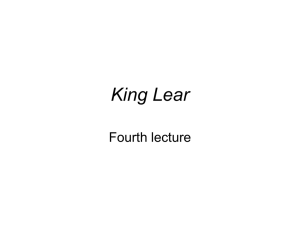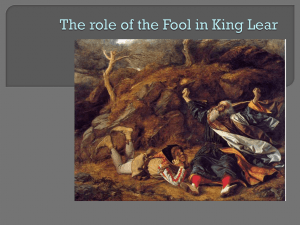Deconstruction Critical Theory: King Lear Analysis
advertisement
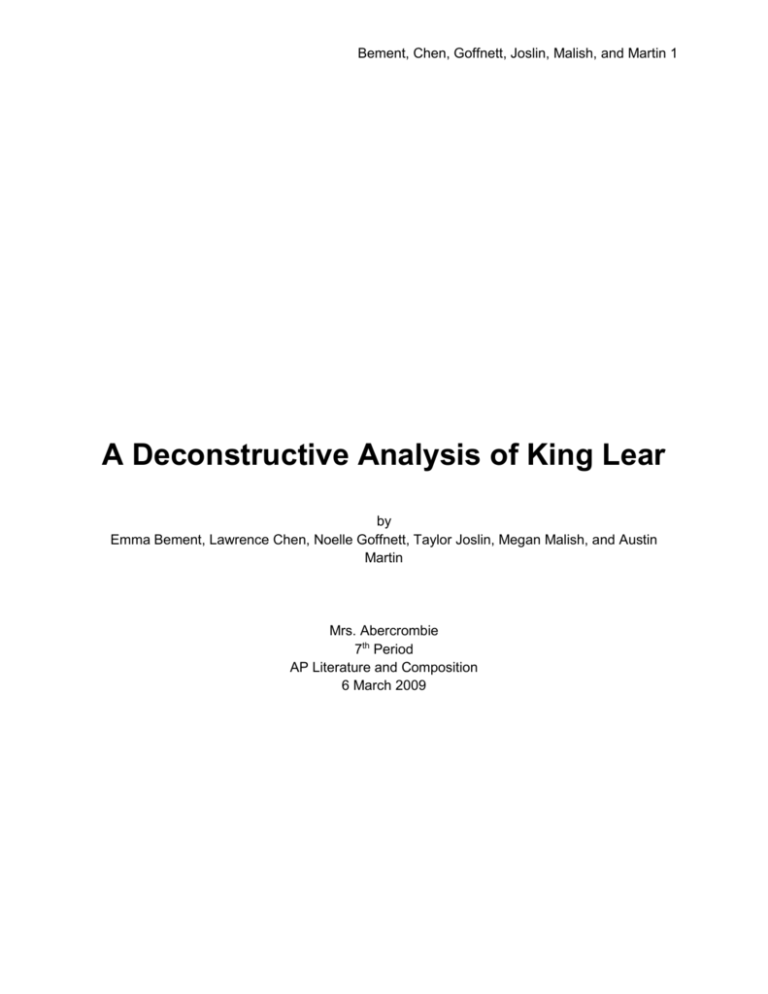
Bement, Chen, Goffnett, Joslin, Malish, and Martin 1 A Deconstructive Analysis of King Lear by Emma Bement, Lawrence Chen, Noelle Goffnett, Taylor Joslin, Megan Malish, and Austin Martin Mrs. Abercrombie 7th Period AP Literature and Composition 6 March 2009 Bement, Chen, Goffnett, Joslin, Malish, and Martin 2 One look at complex clockwork, and one is easily awed and fascinated with the seemingly perfect interconnectivity of each piece to work as a whole. A close analysis of each individual gear, each individual spring, and one gets a better image of the contraption as a whole. Deconstruction is exactly this -- an objective analysis of each part of the whole. However, each piece is observed as it is; the gear is still a gear and the spring is still a spring. No unnecessary parallels are made between a literal object and a figurative meaning. Everything is to be taken at face value. Founded by French philosopher Jacques Derrida in 1966, Deconstructive critical theory sought to question everything -- even the language that discussed it and defined it. Popularized in the late twentieth century, Deconstruction was a method in which one could find the most literal meaning of any text. Picking apart each small aspect of the writing, the only evidence that can be cited was evidence that comes from the text itself. Seeking, though not reaching a purely objective point of view, Deconstruction completely disregards everything about the author: when he or she lived, the circumstances in which he or she lived, and whether or not they had a key message that they wished to communicate to their readers. Essentially, any references can only come from the text, and there is no writer -- the text simply is. (Maley) It in itself is an island, and all of its pieces remain in that isolated space. Much like a laboratory experiment, in which one separates independent elements, fearing contamination, Deconstructive critical theory seeks to eliminate all previous preconceptions by a reader or analyzer: judgments made with other texts in mind, or external influences in analysis. (Lye) When it comes to texts, William Shakespeare’s play King Lear is completely full of intertextual as well as intra-textual connections and references. This makes King Lear a superb text to analyze deconstructively -- there is as much to analyze as there is to disregard, creating an Bement, Chen, Goffnett, Joslin, Malish, and Martin 3 entirely unique analysis. The protagonist of the play, King Lear makes for a fascinating character to deconstruct. In the play, he is mad, or at least giving the appearance that he his mentally unhinged. This means that he is producing incredible amounts of text and material that may or may not truly apply to the character. Like a really bad Google search, one must sift through nonsense and valuable material to find the most profound analysis. A similar phenomenon occurs with the search for the true nature of King Lear; it is eclipsed by his madness. And while most critical theories might seek Shakespeare’s background, agenda, or influences to explain away the truth of things, Deconstruction must dig deeper to find the answer in the text itself. Where else could it be? Where else could Shakespeare have meant it to be? No place but within the text. In Act I, Scene I of King Lear, the great King calls his court into assembly and tells the technique he will use in order to decide how to divide his kingdom amongst his three daughters: a game of flattery. While the elder two daughters play along and bombard him with honeyed lies, the youngest daughter, Cordelia, does not. In a blind rage, King Lear banishes her, and a most loyal Earl Kent, for defending her. In a subconscious attempt toward comprehension, these actions lead the reader toward asking many questions and making a variety of assumptions. For example, the reader might ask, “why did King Lear divide his kingdom between his daughters as he did?”. This could be answered in an infinite number of ways. Potentially, it could be due to his dementia, because he wanted to feel validated by his daughters, or because he wanted to prevent a war over the land. In reality, it could be due to anything, but deconstruction argues that the reader cannot assume it was due to anything. Since the text offers no explicit explanation, it is not up to the reader to decide King Lear’s motivation. It must simply be accepted for what it is. Likewise, it is unclear why King Lear decided to make such a drastic decision as banishing Cordelia from the kingdom, especially if she was Lear’s most beloved child. The only constant that we can assume in this scene is Bement, Chen, Goffnett, Joslin, Malish, and Martin 4 Lear’s anger. The anger can explain the banishment, but what explains the anger? Again, it could be a multitude of things, but the text can not provide any concrete reason for King Lear’s fury. The drama of this decision leads the reader to immediately seek the justification for Lear’s reasoning. As a mature, independently thinking reader, a subconscious decision is made, but once again, deconstruction argues that the reader must disregard these subconsciously determined questions and answers. Essentially, meaning is revealed through stripping away every facet that was once viewed as revealing meaning in itself. Because the reader is not Lear, nor is the reader the author, the reader does not know his reasoning. It is as simple, and complex, as that. In this opening scene, King Lear transitions from a once powerful king to a mentally unstable elderly man facing the realities of having to divide his land between his daughters due to his lack of male heirs. After the banishment of Cordelia and Kent, and giving Goneril and Regan everything they wanted from him, he sets himself up for isolation from both the people that love him and would serve him willingly. Lacking the power he once had, he seeks to justify the choice he has made by seeking adoration from his family. Though he will receive the words he is asking for, Lear will soon find that the love Goneril and Regan professed to him was superficial. The elder sisters are treating their father only as a stepping stone to gain power. King Lear is left with nobody that loves him and is unable to receive the confirmation he is seeking. As the story progresses, Lear is ousted from his kingdom by the daughters he thought loved him. In Act III, Scene II, Lear leaves with the Fool and a disguised Kent with no purpose or direction as a powerful storm rages. By this point, King Lear is having a harder time determining reality from the madness that is steadily consuming his mind. The text in this scene is able to provide a symbolic setting with the torrential downpour. King Lear is losing his mind, Bement, Chen, Goffnett, Joslin, Malish, and Martin 5 and the violent weather clearly foreshadows what is to come later in the play. When the Fool tells him to seek shelter, Lear denies his help and curses his daughters for their cruelty. The Fool is an essential character in this scene, but his purpose is debatable. While he could just be attempting to comfort King Lear by getting him out of the storm, he also has a knack for speaking the truth to a man whose rationale is being clouded by madness. But because of deconstructive critical theory and indefinite nature of King Lear, nothing can be certain. The Fool’s role in this scene especially, is not given. The fool best illustrates the role reversal that has taken place. The king is foolish while the Fool is wise. King Lear’s decent into madness reaches a degree that seemed incomprehensible only days before. The once great king is nothing more than an old man exposed to the elements with only a fool and Kent, an loyal nobleman unknown to Lear, to accompany him. Without the company of Cordelia, perhaps the only person who loves him, Lear will become increasingly enveloped in his madness. After the scene in the storm, King Lear’s sense of reality continues to be increasingly impaired. When he is reunited with Cordelia, he does not recognize her at first. He is too distraught to make sense of anything. Eventually he admits to his madness but feels as though Cordelia wants to kill him for what he did to her. Cordelia, however, has different plans and instead forgives her father for banishing her and asks him to join her and her troops to punish his daughters for their crimes. In the final Act V, Scene III, the war sadly ends with Edmund’s victory, and ultimately the capture of both Cordelia and Lear. Though he claimed the victory, Edmund is then challenged by his brother Edgar and dies from a fatal wound, but not before he gives the orders to have Cordelia hanged. This may have happened for a number of reasons. It could be because Cordelia was seen as a threat to Edmund, as Cordelia was the only sister who wasn’t willing to sacrifice family for power, or he may have been jealous that she was the only one not in love with him. It may also have been a final act of power over their family. When Bement, Chen, Goffnett, Joslin, Malish, and Martin 6 Lear holds his daughter for the last time, he finally realizes that she was the only one who truly loved him all along. However, before anything else can be done, Lear suddenly dies. It might have been caused by a broken heart, his old age, or his madness finally catching up to him. Due to the deconstruction theory and the ambiguity of King Lear however, readers will never know the true reason behind Edmund’s final act, or why King Lear died so suddenly. Bement, Chen, Goffnett, Joslin, Malish, and Martin 7 Works Cited Lye, John. "Deconstruction: Some Assumptions." Brock University Department of English Language & Literature. Brock University, 30 April 2008. Web. <http://www.brocku.ca/english/courses/4F70/deconstruction.php>. Maley, Dr. W. T. "University of Glasgow: Deconstruction for beginners." Message to Multiple recipients of list DERRIDA . Mon, 13 Nov 1995 10:24:02 GMT. E-mail. Shakespeare, William. King Lear. Web ed. Shakespeare-Literature.com, 2003. A1,S1; A3, S2; A5, S3. Web. <http://www.shakespeare-literature.com/King_Lear/>.

